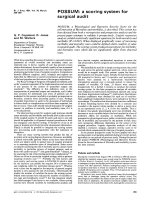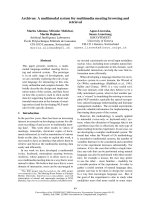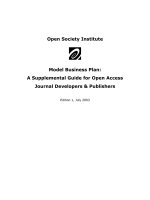STRATEGIC BUSINESS PLANNING A DYNAMIC SYSTEM for improving performance & competitive advantage pdf
Bạn đang xem bản rút gọn của tài liệu. Xem và tải ngay bản đầy đủ của tài liệu tại đây (2.7 MB, 381 trang )
STRATEGIC
BUSINESS
PLANNING
STRATEGIC
BUSINESS
PLANNING
for improving performance & competitive advantage
A DYNAMIC SYSTEM
CLIVE READING
2ND EDITION
London and Sterling, VA
First published in 1993
Second edition, 2002
Apart from any fair dealing for the purposes of research or private study, or
criticism or review, as permitted under the Copyright, Designs and Patents Act
1988, this publication may only be reproduced, stored or transmitted, in any
form or by any means, with the prior permission in writing of the publishers,
or in the case of reprographic reproduction in accordance with the terms and
licences issued by the CLA. Enquiries concerning reproduction outside these
terms should be sent to the publishers at the undermentioned address:
Kogan Page Limited
120 Pentonville Road
London N1 9JN
UK
© Business Knowledge Transfer Ltd, 1993, 2002
British Library Cataloguing in Publication Data
A CIP record for this book is available from the British Library.
ISBN 0 7494 3807 X
Typeset by JS Typesetting Ltd, Wellingborough, Northants
Printed and bound in Great Britain by Biddles Ltd, Guildford and King’s Lynn
www.biddles.co.uk
Contents
Introduction 1
Part 1 The strategic business planning framework 5
1 The purpose of strategic business planning 7
What is strategic business planning? 7; The confused
company 8; The focused company 11; Serving the
customer 15; The benefits of SBP 16
2 Understanding the framework 17
Company purpose 17; Goals 25; Performance targets 36;
Action programs 42; Summary 43
3 Company purpose 44
The overarching purpose 44; The business model 48; Profit 57;
Process 57
4 Distinctive capability 58
Characteristics of distinctive capability 58; Distinctive capability
comes from business processes 63; Developing a new distinctive
capability 64; Overall competence 66; Traditional thinking 67;
Strategic assets 70; The new distinctive capabilities 72;
Competitive advantage 74; Developing new distinctive
capabilities from the old 75; Distinctive capability and the
strategic plan 76; Outsourcing and distinctive capability 77
5 Market/product/service 79
Summary 106
6 Identity 107
The value proposition 107; What is identity? 109; Customers’
actual perception 112
7 People 117
The resource pool 118; Business values and company
culture120
8 Efficiency 142
Summary 149
9 Synthesizing the strategy 150
Effective strategy 150; Three generic strategies 155; Company
strategy 158; Fixed cost base reduction 160; Process cost base
reduction 160; Differentiation 161; Combined low cost and
differentiation 164; Principles for a general cost reduction
strategy 164; Principles for a general differentiation strategy 166;
Assumptions 168; Strategic options summary 169; Successful
strategies 171
10 Completing the SBP framework 172
Developing the performance targets 172; The draft first
report 175; Refining the plan 176
11 Evaluation 179
Test the logic 179; Test the soundness 179; Financial
analysis 184
Part 2 Strategic concepts 185
12 Degree of strategic change 187
13 The role of the hypothesis 200
Death of a salesman 201
14 Simple strategy in a complex world 223
vi Contents
Part 3 The strategic business planning process 231
15 The development process 233
The strategic business planning structure 233; Planning 235;
The terms of reference 236; Data collection 238; Building the
team 239; Data analysis 239; The development of the plan 239;
Format and presentation 240; Evaluation 240; Implementation
241; The process of strategic business planning 241; Organizing
a workshop 242; Starting the process 243
16 The reasoning and psychology of SBP 245
Robust strategy 245; Implementation 246; The SBP psychology
247; Learning through the SBP process 250; Communicating the
strategy 252
17 Building the leadership team 255
Emotions and tensions 255; The role of the leadership
team 256; The motivations of leadership team members 257;
Team roles 262; Adding value 263
18 Implementation 265
Communicating the strategy 265; The first year 267; Long-term,
fundamental or complex performance targets 270; Prioritizing
performance target 270; Performance targets 270;
Instructions to PTTs at the start of the project 274; Action
program decomposition 275; Monitoring attainment 275
19 Data collection 276
The base data 276; Base data forms 290
20 Financial analysis 296
Introduction 296; Analysis of assets and liabilities 297; Analysis
of performance 300; Using the analysis to compare two
companies 303; Traditional cost accounting 305; Activity-based
costing 307; The 10 per cent rules 308; Business unit cells and
market/product units 313; Monthly management performance
summary 313; Increasing management impact 315; Develop
financial requirements for next budget year 317; Organizing the
financial analysis workshop 318; Calculations 319
Contents vii
21 Business analysis 323
Introduction 323; Organization of the business analysis
workshop 324; Three-stage sieve 324; The base analysis 325;
Strengths and weaknesses analysis 330; Summary 334
22 Some useful techniques 335
Introduction 335; Product/service analysis 335; External
appraisal 342; Organization 352; Chapter summary 363
23 Summary 365
The rules of strategy 366; Strategic thinking 366
Index 368
viii Contents
Introduction 1
Introduction
Most senior executives think they know how to plan and implement
strategy for their company or strategic unit. The difficulty they often
have is that their approach is:
l
ad hoc and developed in response to a particular situation;
l
concentrated on limited functions or activities in the company;
l
not an organized, comprehensive, process;
l
not fully implemented.
The strategy they do develop is not robust and will change with even
slight economic downturns or industry trends. Companies unable to
hold to an agreed course, even over a period of three to five years, will
never perform strongly. Robust strategy requires pursuing the most
attractive strategic targets, focusing the resources of the business on
them and aligning the organization, systems and technology to support
their achievement.
Achieving focus in a company is not easy. Many members of the
leadership team will have reached their position through being success-
ful in one particular function, even though they may have worked in a
number of different functions. They will tend to have a mindset formed
of their earlier experiences. Bringing all this experience together to create
a strategy can be a great strength, but it needs a unifying process to
ensure there is ownership of the strategy in all members of the leader-
ship team.
Fourteen years ago I developed the concept of strategic business
planning, linking company purpose, business goals, strategy, performance
2 Strategic business planning
targets and the action program in one framework. Having now worked
with some 80 businesses in Europe, North America and Asia, many of
them over a number of years, the success of the approach is proven.
Over 700 top executives, 75 per cent of them chairmen or CEOs, have
attended my one-day seminar. Many of those who have implemented
the system have told me how effective they found it in developing
highly competitive, sustainable strategies and, equally importantly,
consensus and commitment within the leadership team and active
endorsement from employees.
The approach is to ensure that the strategy is owned by the leadership
team and the action program by executives and employees throughout
the organization. This is the key to successful implementation.
The approach is not a fad, but a robust business process to improve
the performance and competitive position of a company. If the leader-
ship team want to try a new approach to business this can be incorpor-
ated into the system, but it will clearly be part of an overall strategy,
not an isolated initiative. The Internet and the impact of e-commerce
are all encompassed within the approach.
In a fast-changing world, strategy has to be capable of encompassing
radical change, continuous improvement and the options in between.
The part on strategic concepts, which has been developed mainly over
the last three years, enables leadership teams to understand the cycle
of strategy and develops ideas on how they can consider, decide and
implement radical strategy as well as strategies for competing within
the existing market/product/service arena.
All the top executives and leadership teams that I know are under
time pressure; there is always more to do than the time to do it. Most of
them work long hours in managing the business for today, winning
new orders, keeping operations moving with continuous efficiency
improvements and ensuring they meet the short-term expectations of
their owners and Wall Street.
This approach uses their time effectively and sparingly. It can take
no more than five days of their time over a period of two to four months
to develop a robust strategy that will create new competitive advantage
and focus the whole business on generating better returns for their
intellectual, managerial, energy and resource inputs.
A clear strategy that is understood by employees, customers, investors
and all stakeholders, and that has the universal support of the entire
leadership team and board of directors, is essential to any successful
enterprise, be it business or non-business. Strategic business planning
will enable the leaders of companies to develop that strategy.
Introduction 3
The book is structured in three parts. The first part concerns the
development of the strategic business planning framework. It is this
framework that ensures that the strategy that is developed is robust
and involves the entire business. The second part outlines some strategic
concepts that help to ensure that the strategy is ambitious and allows
for the potential changes in the business environment. The third is
concerned with how the strategy is developed, owned by the leadership
team, cascaded through the organization and implemented.
PART ONE
The strategic business
planning framework
Developing a strategy that will lead to sustainable competitive advan-
tage and can be effectively implemented requires a clear strategic frame-
work and a structured process.
This part describes the outline of a strategic framework that has
proved highly successful in over 80 companies, from small businesses
to large corporations. The process is usually developed using workshops
for the leadership team. In this part there is occasional reference to
workshops; this is simply to help the reader think how these areas could
be developed. A fuller description of workshops is included in Part 3.
1
The purpose of strategic
business planning
WHAT IS STRATEGIC BUSINESS PLANNING?
Strategic business planning (SBP) is the key to developing a business
so that it runs effectively and efficiently. This may involve developing
different products, services or markets. It may involve acquiring
compatible companies or changing the whole nature of the business,
such as when Richard Branson, the founder of the Virgin Group, decided
that he wanted to diversify away from the music business into the airline
business. It can incorporate any management concept, such as re-
engineering, total quality or time based management. It is a process,
not a management fad product, based on a proven strategic framework
that is effective in setting direction and improving performance for
businesses of all types and for divisions and departments within
corporations. It incorporates the two fundamentals of strategy, deciding
where you want to go and how to implement operational initiatives to
take you there, coherently in one process.
Users of the process include companies with a single managing head
and 50 employees to the largest multinational corporations. They use it
every year as a means of constantly re-evaluating the strategy, modify-
ing the direction if necessary and planning the next phase in its
development.
The real value of SBP lies in the planning process: discussion,
developing new understanding, new insights and generating new ideas
8 The strategic business planning framework
for the business. It does not lie in developing a written plan. It has been
suggested that the night before a business plan is published it should
be burnt, because the process should be continuous, not a one-off
exercise. The first time the executives use the process they set up a
framework that should last for between three and five years, although
it will be challenged at least every year. This framework makes it easier
to develop the plan for each succeeding period, but the process of
planning and making adjustments continues as long as the business
survives.
The aim is for everyone in the business to think and manage
strategically.
Strategic business planning is about setting a direction for the
business, a direction to which everybody, executives and employees,
can become committed. It ensures every part of the company is in
harmony, moving towards a clear business purpose that will give it a
competitive advantage and improve its performance.
THE CONFUSED COMPANY
One of the questions often asked of participants on management courses
is ‘what is good management?’ The group will come up with a whole
string of words: commitment, delegation, motivation, listening, and
praise. Eventually someone offers the word ‘leadership’. Leadership is
enthusing people with where they are heading and motivating them
to take the steps to move in that direction. In this sense this book and
the entire SBP process is about leadership.
Next I ask them ‘what is poor management?’ Besides descriptions of
the opposite of good management, such as poor communication, lack
of honesty, criticism of employees, there is always one word that
emerges: confusion. Poor management confuses. Every one of our client
companies that had performed poorly was riddled with confusion.
Middle managers were the most confused, the workforce was usually
demoralized, and the thinking members of top management were
depressed. They knew things were wrong, that the company ran by
fire-fighting, that customer service was poor and complaints were not
dealt with quickly, that staff left because they found their work unsatis-
fying. But they did not know how to remedy the situation.
Conceptually this kind of company can be represented as shown in
Figure 1.1. Each department is looking in a different direction, and there
is no overall focus to bring them together.
The purpose of strategic business planning 9
I used to think the confused company was just an accident caused by
lack of focus. Then some specific experiences indicated that it is often
the result of deliberate intent. Sometimes it is caused by executives
determined to have their own way even if they know that what they
plan to do is not for the overall good of the business. Many such
companies are intensely political organizations and to achieve anything
requires what amounts to a coalition of executives to support it and
make it work. Obtaining the support of a colleague for your plan implies
giving him or her your support when needed for their plan. The overall
needs of the company are lost sight of in this process of negotiated
reciprocal support, yet executives using this approach are often the first
to complain about lack of performance.
However, more often this push in different directions is caused
inadvertently by executives trying to do something to improve the
business. Their problem is that there are no clear guidelines on where
the business is intended to go and therefore no clarity about the actions
necessary to take it there. Not surprisingly, they all try to improve the
business by doing what they perceive to be best for their particular
function or division, rather than planning for the overall performance
of the entire organization. They end up by taking different and often
contradictory actions that are followed by recriminations among the
executives and further disharmony.
Figure 1.1 The confused company
The confused com
p
an
y
F
inance
Operations
Sales
R & D
Marketing
HR
10 The strategic business planning framework
This is rational considering that most departmental or functional man-
agers have primarily developed through one function, say marketing,
operations, finance, HR or IT. They have a perspective that maximizes
the performance of that function. In operations it might be maximizing
the utilization of operatives or resources, or cost minimization for
manufacturing a product or delivering a service. It might include
inventory reduction. For marketing it might be market share or mind-
share achieved through advertising and promotions. In sales it might
be maximizing revenue, which might involve high service levels and
higher inventories as well as discounts for major customers. Finance
might seek to maximize profit, cash flow or earnings per share. HR
might be considering meeting recruitment requirements, relative pay
scales and maintaining harmonious union relationships. For most CEOs
growing the business will be their prime goal. Conceptually this is
shown in Figure 1.2.
Figure 1.2 Mismatch of goals in a typical company
Even in corporations where there is a rational strategy, the way it is
understood and interpreted by the board of directors, the president and
vice presidents can be very different. The different strategic message
they communicate down the line results in chaos at middle manage-
ment and operating levels.
COO VP Finance
O
p
eratin
g
EPS
Profit
SBU Heads Support functions Controller
SBU operating Meeting function Conformance
performance requirements to budgets
VP HR VP Operations VP Sales VP Marketing R&D
Comparative Operating Sales Market share Technology
salary cost Mindshare
CEO
Growth
The purpose of strategic business planning 11
This type of organization seldom performs effectively or efficiently.
To do so it has to be focused, united and absolutely clear on the goals to
be achieved, the strategy for achieving them, the timescale, the resources
required and the action program and implementation responsibilities.
What is being described here can sometimes appear to be the rule
rather than the exception. Time and time again when one of my clients
makes an acquisition and starts to understand the business they have
purchased they are amazed at the confusion. The business may be
profitable and even growing at a reasonable rate, but the waste of effort,
the cost of delivery, the frustration and above all, the missed oppor-
tunities caused by poor leadership and management is staggering.
There are two concepts that executives and managers in confused
companies do not understand. The first is quite simply to ensure that
all parts of the company know and are working towards the same
purpose. Understanding this is the first step to achieving it. The second
step is to grasp that the business purpose is a unified, total, holistic
concept for the whole business. It is not just a marketing, product
development or sales strategy. It is the focus of everything that happens
in the organization and depends on implementation throughout the
whole organization for its success.
Throughout most of this book reference is made to working on an
organization-wide basis. However, the approach will work effectively
for divisions and subsidiaries that have autonomy to operate within
boundaries specified by the corporate parent.
The approach is to think through the purpose of the division or
department and decide what it contributes to the total organization that
could not be obtained from another source within the organization or
through outsourcing. By working through the five goals, the role and
contribution of the unit (now and what it should be in the future) will
become clearly understood. The strategy can then be developed to
enable the division or department to make a more effective contribution
to the entire enterprise.
THE FOCUSED COMPANY
Focus is what the strategic business planning process achieves. It enables
an organization to operate as shown in Figure 1.3, by providing a forum
and a structured process to resolve internal confusion and to channel
energy and effort in a commonly agreed direction.
12 The strategic business planning framework
The result is an organization where functions and departments are
directing their efforts to achieve a common purpose. In addition, the
way people, systems and technology are organized and resourced
supports the functions in moving towards that common purpose.
Theory is fine, but how is it put into practice at the sharp end? My
guarantee is that if you really apply and implement the process to
develop the framework described in this book your business will come
to resemble the focused company model.
Communicating a clear strategy to employees and ensuring they
understand how their contribution is important for its success is the
first requirement for creating a focused business. At a detailed level
what is required is that everything in the company is aligned with the
company purpose. This is shown in Figure 1.4. This is obviously not a
complete list, but serves to indicate the range of issues that must be
aligned to maximize company performance.
The second requirement paraphrases Peter Drucker and his ‘Effective-
ness is doing the right things, efficiency is doing things right’ (Drucker,
1974). This encapsulates the overriding difference between high-
performing and low-performing companies. (Drucker actually said
‘Effectiveness is doing the right things. Efficiency concerns itself with
the input of effort into all areas of activity.’)
There is a well-known tenet in business called the 80/20 rule, or the
Pareto principle. This states that 80 per cent of results come from 20
Figure 1.3 The focused company
Pur
p
ose
S
y
stems
Technolo
gy
Peo
p
le/Or
g
anization
Operations
Marketing
Sales
HR
Finance
R&D
The purpose of strategic business planning 13
per cent of their possible causes: for example, 80 per cent of sales come
from 20 per cent of customers, 80 per cent of problems come from 20
per cent of the product lines, and 80 per cent of stock value is in 20 per
cent of stock items.
This can be extended to senior executives’ decisions and actions: 80
per cent of a manager’s impact comes from 20 per cent of his or her
actions.
Actions or decisions with high impact are those that affect the
company strategically, rather than those that merely concern its normal
operating routine. They concern, for example, changing the business
model, focusing on new market sectors, fundamental improvements
in customer service, making critical investment decisions, obtaining a
better return on research and development expenditure. Such actions
or decisions affect the company’s longer-term performance and enable
it to achieve competitive advantage.
How this concept is applied to managers’ decisions is illustrated in
Figure 1.5.
Strategic decisions will be fewer in number than operational ones
but will have a longer-term impact on the company. They are the domain
of top executives and senior managers. Maintenance decisions are of a
day-to-day, operational nature. They are critical to keeping the company
running, but their impact is usually short-term. The nature of the SBP
Figure 1.4 Company purpose
Pur
p
ose
IT systems
Culture
Pricing
Marketing
P
ersonal goals
Recruitment
Information
Policies
Identity
Management
style
R&D
Products/
services
Rewards
Competencies
Organization
structure
Control
systems
Appraisal
reviews
Processes
Skills
SBU Strategies
Values
Development
projects
14 The strategic business planning framework
process is such that the executives will focus far more on strategic issues
which address the future of the company and which will automatically
increase the effectiveness of their contribution.
Some actions are negative: the production manager keeping the line
busy with parts that are seldom required, the salesman offering
discounts that mean selling at a loss and the engineers designing
products with unnecessarily high tolerances on every dimension when
there is no benefit to be gained from such accuracy. Such things usually
come to the surface and can be stopped, although often a lot of money
is wasted first.
The behavior that is really worrying, and that is endemic among some
senior executives, is the kind that has either no real impact or only a
marginal impact on the company. This kind of behavior ensures that
decisions will be taken which maintain the status quo. It assumes
yesterday will be replicated and does not prepare for tomorrow. Status
quo maintenance decisions do not radically change anything. They do
not dramatically reduce the delivery time of product to customer, or
reduce costs, or improve quality, or add meaning to the job of the
employee. They do not clarify fundamental misunderstandings, or
create a culture that empowers people to make their own decisions.
These maintenance decisions improve the operational efficiency of the
organization and are essential, but they are the provinces of middle
and junior managers and employees, who should be encouraged to
Figure 1.5 Decision impact
Impact
Decisions
+ve
-ve
The purpose of strategic business planning 15
produce all the ‘one per cent’ improvements an organization can
implement. However, executives and managers who only take ‘effi-
ciency’ or ‘maintenance’ decisions are not contributing to the develop-
ment of the organization. They are not preparing it for tomorrow.
Senior managers who take only efficiency decisions do not under-
stand their business role. They either lack the ability to make major
decisions or work in a corporation where making major decisions is
impossible for whatever reason.
The reason middle managers take ineffective decisions is that they
are confused, lack confidence, are not empowered or have no direction;
so they honestly do not know which actions will be effective or where
the executives want the company to go.
SERVING THE CUSTOMER
The senior executives themselves are often the biggest problem. In some
companies, when they are asked how many decisions they have made
in the last week, they often say dozens, or even hundreds. When asked
how many have had a fundamental impact on the business – how many
have changed what they do or how they do it – the response is often a
blank face.
Many executives do not know what they are supposed to be doing:
they do not know what their job is. Collectively the leadership team
has no idea where the company is going.
The confusion that exists in some companies is indicated when I ask
executives what they think their company employs them to achieve.
Often their answer is ‘to earn a profit’. I then explore what they actually
do to earn a profit, using examples of things they have done in the last
week or so. Salespeople and production people find this easier, although
even for them there are many aspects to their job that have only a
tenuous link to profits.
What users of strategic business planning understand is that the firm
has a purpose, a reason for being in existence. That purpose will
sometimes be clearly stated, at other times only vaguely implied.
Whatever that purpose is, everyone on the payroll needs to understand
how he or she contributes to achieving it.
Of course profit is part of the purpose but, by itself, profit is only the
result, the scorecard of doing other things well. The key word I am
looking for is ‘customer’. Without customers, there is no business.
Everyone, from the finance director to the floor sweeper, is there to help
16 The strategic business planning framework
the company provide the best possible service and products to its
customers. That is the ultimate reason that they are employed. If they
cannot answer how they serve that purpose, then they are at best of
dubious value to the organization.
THE BENEFITS OF SBP
The benefits of strategic business planning are threefold:
l
an understanding by all senior management of the business, its
unique attributes, why customers buy from it, and the opportunities
and threats it faces;
l
a clear concept of where the business is going and the actions
everyone will take to move it there;
l
a commitment by the leadership team to make the strategic plan work
and to ensure that the company moves in the direction they have
decided is the best for its future.
The physical and immediate benefit – the plan – is summarized in a
simple framework supported by an action program and a fairly short
report. Its main purpose is to be a record of the process and to ensure
on a regular basis, usually monthly, that the action program is being
followed and is on schedule. What it is not is a sterile document; it is
regularly updated, reviewed and made to live.
2
Understanding the
framework
The strategic business planning framework is the glue that holds the
strategy and implementation together. It provides the focus and
direction and allocates the actions and responsibilities. It can accommo-
date revolutionary or evolutionary strategies.
The process of developing the framework, communicating it to
employees and using its motivating implementation approach will
create a dynamic company. The framework will prove to be very
powerful in helping the leadership team to think and manage the
business strategically. It is shown in diagrammatic form in Figure 2.1.
This chapter gives an overview of the framework and considers its
component parts. The rest of the book then explains the process of how
to develop a unique strategic business plan and framework for your
company.
COMPANY PURPOSE
A company’s purpose is the reason that it exists, and why it will
continue to exist, providing it maintains a competitive advantage. A
business, or any other organization, serves a need in society. It will only
continue as long as society in general, or sufficiently large segments of
society, want it to remain in existence through purchasing its products
or services.
18 The strategic business planning framework
The armaments industry in the free world was created and continues
because a democratic society elects governments who decide that
national security requires armed forces. The armed forces in turn require
modern arms, hence the need for an arms industry. Once the industry
can produce sufficient armaments for its own country it can then, with
its government’s agreement, sell arms to others. In July 1989, when
Gorbachov was changing Russia and peace with the West became the
new policy, I wrote: ‘But imagine for a moment that glasnost proceeds
at a pace that at present seems impossible, that countries in Europe and
the free world agree to stop equipping their armies with new weapons.
Then society’s need for an armaments industry is greatly diminished;
its prime purpose no longer exists.’
That thought, intended to be over the top at the time, is already
history. Since 1989 defense procurement has declined by more than 60
per cent in constant dollars. Estimates suggest that only 25 per cent of
the 120,000 companies that once supplied the Department of Defense
Figure 2.1 The strategic business planning framework
Company
purpose
Efficiency
People
Identity
Market/
product/service
Distinctive
capability
Company
specific
Goals Performance Action
targets program
Understanding the framework 19
are now supplying them; the others have shut down altogether or left
the defense industry. The loss of skilled employees over a period of
time has been greater than that sustained by any other industry in recent
times.
In the 1989 article I wrote: ‘The armaments industry of the Western
world is already repositioning itself to meet a new environment. And
as the primary manufacturers, those companies that design, assemble
and sell the final weapon, begin to develop a new purpose for their
organization, so many of their subcontractors and suppliers will have
to rethink their purpose. The situation is one that abounds with both
opportunities and threats, because there will still need to be an arma-
ments industry. The difference is that it will be smaller and have to
meet different requirements. If they are to profit from the changes,
companies need to rethink their purpose, their goals and their strategy.’
The successful corporations like Lockheed Martin have managed to
do this through understanding the needs of the US Defense Department
and adapting to meet those needs. Lockheed Martin set out to win a
much bigger share of a shrinking market through consolidations with
other companies. They also understood that today’s military aircraft
and fighting ships will have to last for decades. But the electronic and
other technology-intensive parts may become obsolete in five years.
Software components can require updating in two years.
Since in many ways military hardware needs to have relative rather
than maximum superiority, the need is to continuously upgrade existing
hardware at modest expenditure rather than scrap and replace. Com-
panies that structured their business around this purpose have in a
number of instances expanded their business and positioned it with
greater security.
Purpose statements that can really affect a company’s strategy can
come from insights about the market requirements, as with military
suppliers. These are often effective statements provided they are
challenged every year. This does not mean they must change every year.
Purpose statements need to last for a minimum of five years, even in
this age of change.
It is already clear that increasingly company purpose will have to
include not only the provision of products and services that meet the
demands of the market in terms of performance and price, but also how
their creation avoids harming the environment to an unacceptable
degree.









